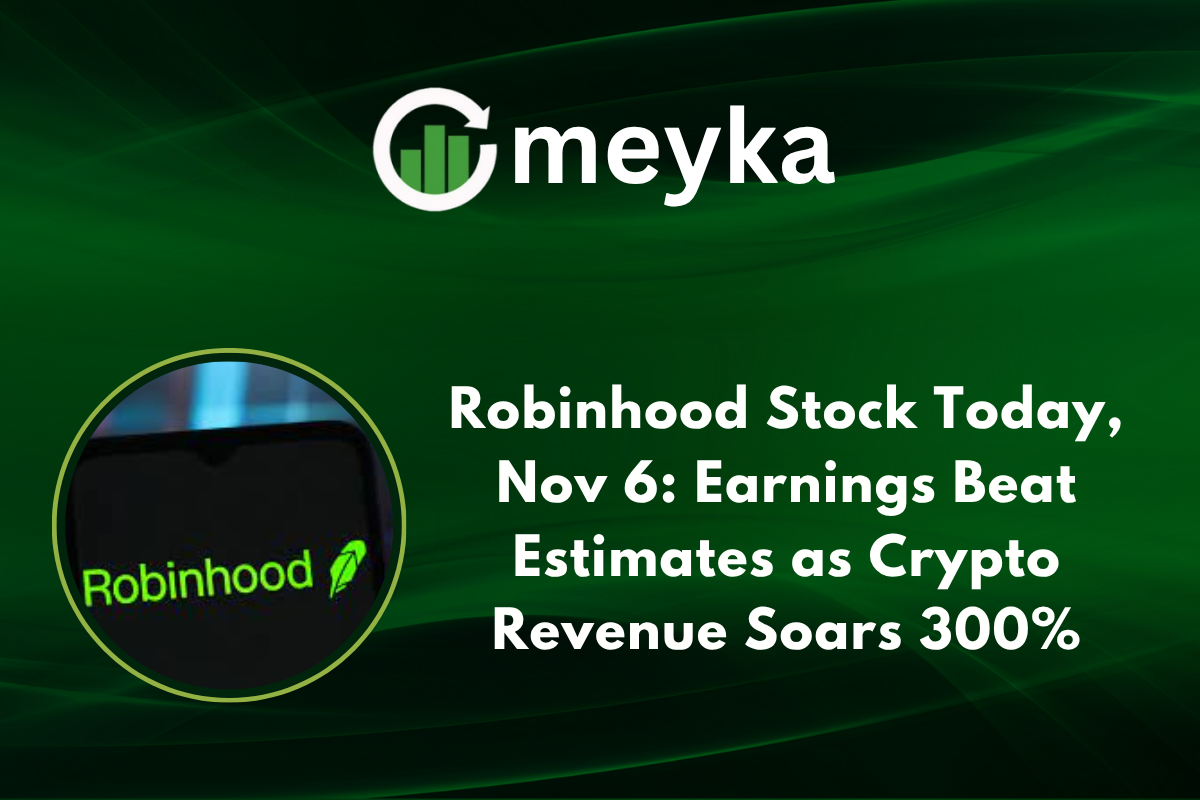Robinhood Stock Today, Nov 6: Earnings Beat Estimates as Crypto Revenue Soars 300%
Robinhood (HOOD) reported a strong third quarter, beating Wall Street on both revenue and earnings. Total revenue came in at $1.27 billion, above expectations. Transaction based revenue surged, led by a dramatic rise in cryptocurrency trading. Crypto revenue jumped roughly 300 percent to about $268 million, a major lift for the quarter. Earnings per share were $0.61, beating consensus.
This mix of numbers shows a clear shift: Robinhood is not just a retail stock app anymore. Crypto, options, and new product lines are driving growth and changing the company’s revenue profile.
Robinhood Stock: The headline numbers
- Total revenue: $1.27 billion.
- Transaction based revenue: $730 million, up 129 percent year over year.
- Crypto revenue: $268 million, up more than 300 percent year over year.
- EPS: $0.61, above estimates.
- Funded customers: record 26.8 million, platform assets near $333 billion.
These are the numbers investors care about right now. They explain today’s market reaction and the renewed debate over Robinhood’s long term story.
Why the jump in crypto revenue, and why it matters
Crypto activity on Robinhood accelerated in Q3 for a few clear reasons. The company expanded its crypto offerings via acquisitions and partnerships.
Those moves brought larger crypto volumes, and crypto trading tends to carry higher transaction revenue per trade. For Q3, crypto alone added hundreds of millions to the top line, and it accounted for much of the transaction revenue growth.
Why is this happening? Investors moved into crypto trading as price action and volatility returned, volumes rose, and Robinhood’s U.S. and EU product rollouts widened access. The firm’s purchase of Bitstamp and other ecosystem bets helped scale crypto services faster.
Robinhood Stock market reaction and context
Shares moved on the news, reflecting both the upside surprise and investor caution over costs. The market often rewards revenue beats. However, elevated expenses can temper enthusiasm. For context, Reuters’ earlier coverage of Robinhood’s trend into crypto and retail trading volatility shows this is not a one quarter story, but part of a multiyear shift.
For traders and long term holders, this means watching two things: crypto volumes and the company’s cost trajectory. If Robinhood converts these revenue gains into durable margins, the stock narrative strengthens.
Product drivers and strategic moves
Robinhood’s Q3 gains were not accidental. The company added new business lines, bought exchanges, and widened its product set.
Management highlighted Prediction Markets and Bitstamp as growing contributors, and said these lines could generate meaningful annualized revenue. This strategy aims to diversify away from pure equities and expand higher-yielding transaction sources.
This is where AI Stock research and smart, data driven signals come into play for analysts. Using machine learning to track user behavior and product adoption helps estimate how long the new revenue streams will last.
Risks, regulations, and the competition
Robinhood now operates in a tougher regulatory and competitive landscape. Crypto rules, listings, and policy changes can affect volumes quickly. Traditional brokers and crypto platforms are scaling up, so Robinhood must keep costs under control while defending market share. AI Stock Analysis tools can help surface regulatory risk signals early, but investors should stay cautious.
Reuters’ prior reporting on Robinhood’s shifts shows how quickly trading patterns can change after policy or market events, reinforcing the need for active monitoring.
Social signals and market buzz
Social commentary amplified the news. Two notable posts captured immediate reactions and helped shape the Twitter and crypto community conversation: a Tweet from Powerdrillbloom and a post from RealCoinCentral. These social references underscore investor sentiment and trading chatter on Q3 beats. See the tweets here:
For readers who follow market flow, these social signals often act as early indicators of retail trading momentum.
Conclusion
Robinhood’s Q3 report shows the company is successfully shifting its revenue mix, with crypto now a major contributor. The beat on revenue and EPS validates recent strategy moves, yet higher operating costs mean investors must watch margin trends closely.
If Robinhood sustains transaction volumes and converts new lines into stable recurring revenue, the stock’s long term outlook improves. For now, the story is growth with caution: strong momentum, evolving product mix, and clear execution risks. AI Stock driven monitoring and active portfolio checks are advised for investors who want to follow this fast changing company.
Bottom line: Robinhood delivered a strong quarter, crypto led the charge, but cost control and regulatory hurdles will shape the next leg of the stock’s journey.
FAQs
Yes, revenue and EPS topped consensus, driven by transaction based gains and crypto.
Growth looks real now, but sustainability depends on crypto market cycles, fee mix, and how well Robinhood monetizes new services beyond trading.
Management flagged higher operating expenses and raised guidance for some costs, which could pressure margins if growth slows.
Disclaimer
The content shared by Meyka AI PTY LTD is solely for research and informational purposes. Meyka is not a financial advisory service, and the information provided should not be considered investment or trading advice.






